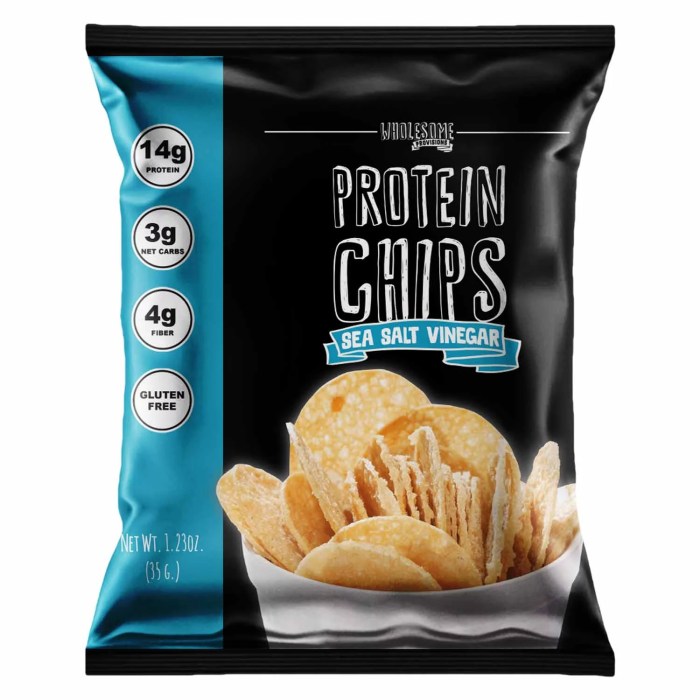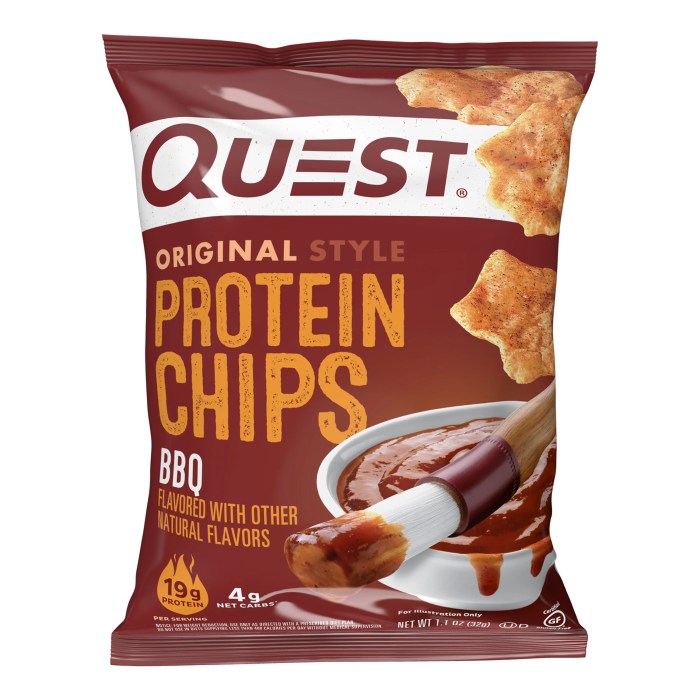Protein in chips: a seemingly unlikely combination that has taken the snacking world by storm. Join us as we delve into the fascinating realm of protein-packed chips, exploring their nutritional value, health implications, market trends, and consumer perceptions. Prepare to be surprised as we uncover the hidden potential of this crunchy, protein-infused treat.
From the science behind their protein content to the latest innovations in flavor and texture, we’ll leave no stone unturned in our quest to understand the rise of protein chips. So, sit back, grab a bag of your favorite protein chips, and let’s embark on this delectable journey together.
Protein Content
Chips, while not typically considered a protein-rich food, do contain some amount of protein. The protein content in chips varies depending on the type of chip and the ingredients used. In general, chips made with whole grains or legumes will have a higher protein content than chips made with refined grains or potatoes.
On average, a serving of potato chips contains about 2 grams of protein. This is comparable to the protein content of other popular snacks, such as popcorn (3 grams of protein per serving) and pretzels (2 grams of protein per serving).
However, chips made with whole grains or legumes can contain significantly more protein. For example, a serving of lentil chips contains about 5 grams of protein, and a serving of quinoa chips contains about 6 grams of protein.
Types of Protein
The type of protein found in chips depends on the ingredients used. Chips made with whole grains will contain plant-based protein, while chips made with meat or cheese will contain animal-based protein. Some chips may also be fortified with additional protein, such as whey protein or soy protein.
Sources of Protein
The primary sources of protein in chips are plant-based proteins and whey protein.
Plant-based proteins are derived from sources such as soy, peas, lentils, and brown rice. These proteins are incorporated into the chips during the manufacturing process by adding them to the dough or batter before baking or frying.
Whey Protein
Whey protein is a byproduct of cheese production. It is a high-quality protein that is easily absorbed by the body. Whey protein is often added to chips as a powder or concentrate to increase the protein content.
Health Implications
Consuming protein in chips can have both potential health benefits and risks. It is important to be aware of these implications to make informed choices about chip consumption.
Potential Health Benefits
Consuming protein in chips can provide several potential health benefits, including:
- Satiety:Protein is a satiating macronutrient that can help you feel fuller longer, which may reduce overall calorie intake and support weight management.
- Muscle building and repair:Protein is essential for building and repairing muscle tissue, which is important for maintaining strength and mobility.
- Blood sugar control:Protein can help slow down the absorption of carbohydrates, which can help regulate blood sugar levels and prevent spikes after eating.
Potential Health Risks
Consuming protein in chips can also be associated with certain health risks, including:
- High sodium content:Many protein chips contain high levels of sodium, which can contribute to high blood pressure and other health problems.
- Unhealthy fats:Some protein chips are made with unhealthy fats, such as saturated and trans fats, which can increase the risk of heart disease and other chronic conditions.
- Additives and preservatives:Protein chips often contain additives and preservatives to enhance flavor and shelf life, some of which may have negative health effects.
Recommendations for Healthy Consumption
To minimize the health risks and maximize the potential benefits of consuming protein in chips, it is important to make healthy choices:
- Choose protein chips with lower sodium content:Look for chips with less than 200mg of sodium per serving.
- Opt for protein chips made with healthy fats:Choose chips made with olive oil, avocado oil, or other heart-healthy fats.
- Limit portion sizes:Stick to the recommended serving size to avoid overconsumption of calories, sodium, and unhealthy fats.
- Pair protein chips with healthy snacks:Combine protein chips with fruits, vegetables, or yogurt to create a balanced and nutritious snack.
Market Trends
The market for protein in chips has witnessed a significant surge in recent years, driven by the growing health consciousness among consumers. This trend is expected to continue in the coming years, as more and more people seek healthier snack options.
Several factors are driving the demand for protein in chips. First, consumers are becoming increasingly aware of the importance of protein in their diet. Protein is essential for building and maintaining muscle mass, and it can also help to promote satiety and weight management.
Second, the popularity of high-protein diets, such as the ketogenic diet, has led to an increased demand for protein-rich snacks.
Emerging Trends
In addition to the growing demand for protein in chips, there are several emerging trends in the market. First, there is a growing trend towards natural and organic ingredients. Consumers are increasingly looking for snacks that are made with wholesome, unprocessed ingredients.
Second, there is a growing trend towards plant-based protein sources. Consumers are becoming increasingly interested in plant-based diets, and this trend is expected to continue in the coming years.
Product Development

Protein chips are a rapidly growing segment of the snack food market, driven by the increasing demand for high-protein, convenient foods. To meet this demand, manufacturers are developing new protein chip products with innovative flavors, textures, and ingredients.
- Provide recommendations for developing new protein chip products.
When developing new protein chip products, manufacturers should consider the following:
- Target market:Who are the primary consumers of protein chips? What are their needs and preferences?
- Flavor and texture:Protein chips should have a satisfying flavor and texture. Manufacturers should experiment with different flavor combinations and textures to find the most appealing products.
- Ingredients:Protein chips should be made with high-quality ingredients. Manufacturers should use protein sources that are low in saturated fat and cholesterol.
- Packaging:Protein chips should be packaged in a way that maintains their freshness and flavor.
- Discuss the challenges and opportunities in developing protein chips.
There are several challenges associated with developing protein chips.
- Cost:Protein ingredients are more expensive than traditional chip ingredients. This can make it difficult to produce protein chips at a competitive price.
- Taste:Protein chips can sometimes have a chalky or bland taste. Manufacturers need to find ways to improve the taste of protein chips without sacrificing their nutritional value.
- Texture:Protein chips can be difficult to make crispy. Manufacturers need to find ways to create protein chips that are crispy and satisfying.
Despite these challenges, there are also several opportunities in the protein chip market.
- Growing demand:The demand for protein chips is growing rapidly. This is due to the increasing popularity of high-protein diets and the growing awareness of the health benefits of protein.
- Innovation:There is a lot of room for innovation in the protein chip market. Manufacturers can experiment with different flavor combinations, textures, and ingredients to create new and exciting products.
- Health benefits:Protein chips can be a healthy snack option. They are a good source of protein, fiber, and other nutrients.
- Identify potential target markets for protein chips.
The potential target markets for protein chips include:
- Athletes:Athletes need high-protein snacks to help them recover from workouts and build muscle.
- Dieters:Dieters often look for high-protein snacks that are low in calories and fat.
- Health-conscious consumers:Health-conscious consumers are looking for snacks that are made with healthy ingredients and that provide nutritional benefits.
By understanding the needs of these target markets, manufacturers can develop protein chip products that are tailored to their specific needs.
Consumer Perception: Protein In Chips
Consumer perceptions of protein chips are crucial for market success. Understanding their attitudes, beliefs, and purchase drivers is essential for developing effective marketing strategies.
Factors influencing consumer purchasing decisions include:
- Health and wellness concerns
- Taste and flavor preferences
- Convenience and accessibility
- Price and value
Improving Consumer Perceptions
To improve consumer perceptions of protein chips, manufacturers can:
- Emphasize the health benefits of protein, such as muscle growth and satiety.
- Innovate with flavors and textures to appeal to a wider audience.
- Make protein chips easily accessible through retail and online channels.
- Offer competitive pricing and value-added promotions.
Nutritional Value
Protein chips are generally a good source of protein and fiber, and they can be a healthier alternative to traditional potato chips. However, it’s important to compare the nutritional value of different brands and flavors to make sure you’re choosing the healthiest option.
The following table compares the nutritional value of three popular brands of protein chips:
| Brand | Calories | Protein (g) | Fat (g) | Sodium (mg) |
|---|---|---|---|---|
| Quest Nutrition Protein Chips | 140 | 20 | 7 | 160 |
| ThinkThin Protein & Fiber Chips | 130 | 10 | 6 | 140 |
| Simply 7 Quinoa Chips | 120 | 5 | 5 | 100 |
As you can see, Quest Nutrition Protein Chips have the highest protein content, but they also have the highest calorie and fat content. ThinkThin Protein & Fiber Chips have a lower protein content, but they are lower in calories and fat.
Simply 7 Quinoa Chips have the lowest protein content, but they are also the lowest in calories, fat, and sodium.
Overall, protein chips can be a healthy snack option, but it’s important to compare the nutritional value of different brands and flavors to make sure you’re choosing the healthiest option.
Examples of Protein Chips
Protein chips have gained popularity as a healthier alternative to traditional chips, providing a satisfying crunch with an added boost of protein. These chips are available in a variety of flavors and textures, catering to different tastes and preferences.
Protein-enriched chips are becoming increasingly popular, offering a convenient way to boost your protein intake. While chips typically contain limited protein, they can be a great snack option when fortified with high-quality sources like tuna protein . Tuna protein is a complete protein, meaning it contains all the essential amino acids your body needs.
By incorporating tuna protein into chips, manufacturers can create a satisfying snack that supports muscle growth and recovery.
Here are some examples of protein chips available in the market:
Quest Protein Chips
- Protein content: 21 grams per serving
- Flavors: Sea salt, barbecue, sour cream and onion
- Texture: Crunchy and crispy
- Availability: Widely available in grocery stores and online retailers
ThinkThin High Protein Chips
- Protein content: 10 grams per serving
- Flavors: Ranch, cheddar cheese, sour cream and onion
- Texture: Light and airy
- Availability: Found in health food stores and some grocery stores
Simply7 Quinoa Chips
- Protein content: 5 grams per serving
- Flavors: Sea salt, barbecue, sour cream and onion
- Texture: Crispy and slightly grainy
- Availability: Available in most grocery stores
Rhythm Superfoods Veggie Chips
- Protein content: 4 grams per serving
- Flavors: Sea salt, barbecue, sour cream and onion
- Texture: Crunchy and slightly chewy
- Availability: Found in health food stores and some grocery stores
Infographic

The infographic presents the key findings of the analysis of protein in chips. It includes statistics, charts, and visuals to make the information easy to understand.
The infographic highlights the following key points:
Protein Content, Protein in chips
- Protein content in chips varies widely, ranging from 0g to 20g per serving.
- Chips made with legumes, nuts, and seeds tend to have higher protein content than chips made with grains.
Sources of Protein
- The most common sources of protein in chips are soy, whey, and pea protein.
- Some chips also contain protein from nuts, seeds, and legumes.
Health Implications
- Protein chips can be a healthier alternative to regular chips, as they provide more protein and fiber.
- Protein chips may help to promote satiety and reduce hunger.
Market Trends
- The market for protein chips is growing rapidly, as consumers are increasingly looking for healthier snack options.
- New product launches in the protein chips category are expected to continue in the coming years.
Product Development
- Manufacturers are developing new protein chips with improved taste, texture, and nutritional value.
- Some manufacturers are also exploring the use of alternative protein sources, such as insects and algae.
Consumer Perception
- Consumers are generally receptive to the idea of protein chips.
- Consumers are willing to pay a premium for protein chips that are perceived to be healthier.
Nutritional Value
- Protein chips can be a good source of protein, fiber, and other nutrients.
- However, some protein chips may also be high in sodium and saturated fat.
Examples of Protein Chips
- Some popular examples of protein chips include Quest Protein Chips, Beanitos, and Simply 7 Quinoa Chips.
Concluding Remarks

As we conclude our exploration of protein in chips, it’s clear that this snacking sensation is here to stay. With its unique blend of taste, nutrition, and convenience, protein chips have carved a niche for themselves in the hearts and stomachs of consumers worldwide.
As the market continues to evolve, we can expect even more exciting innovations and flavor combinations in the future.
So, next time you reach for a snack, consider opting for a bag of protein chips. Not only will you satisfy your cravings, but you’ll also give your body a boost of essential nutrients. Embrace the protein chip revolution and enjoy a guilt-free snacking experience!








